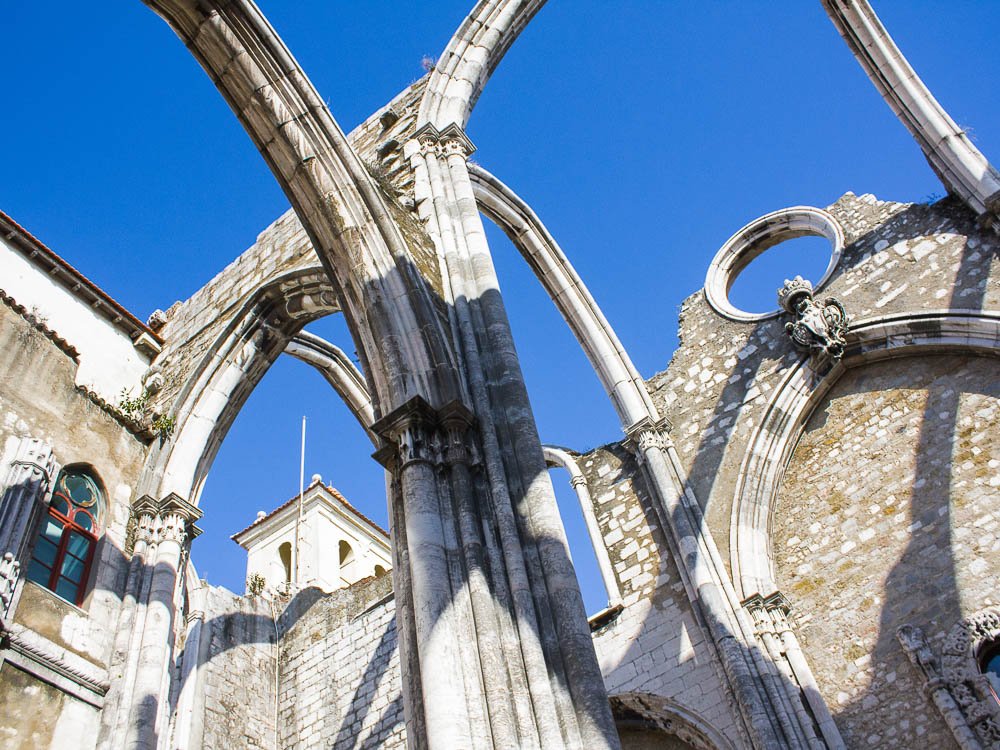Located in central Lisbon, the Carmo Convent is a fascinating piece of Portugal’s history and one of my favorite places in the city. Built in the late 14th century, this Gothic church was very important back then. But on November 1st, 1755, a huge earthquake hit Lisbon and badly damaged the convent.
The rebuilding started the next year but stopped in 1834 when new laws ended religious orders in Portugal. Because of this, some parts of the convent are still open to the sky, and several chapels are still in ruins.
Today, you can visit the Carmo Convent at Largo do Carmo and feel the history and strength of the place. It’s a great way to connect with Lisbon’s past and appreciate its lasting beauty. In this post, I’ll tell you everything you need to know before visiting these beautiful ruins!
Carmo Convent – in a nutshell
- Highlights: roofless church, Archeological Museum with mummies, relics and other objects
- Opening hours: Monday to Saturday, 10am to 6pm (or until 7pm from May to October).
- Best time to visit: morning or late afternoon
- Recommended duration of visit: 1h
- Address: Largo do Carmo 27, 1200-092
- Nearest station: Baixa-Chiado

Index
- How to get to Carmo Convent?
- Tickets
- Opening hours and best time to visit
- Accessibility
- Additional info
- Nearby attractions
- History
- Carmo Convent Archeological Museum
1. How to get to Carmo Convent?

Getting to the Carmo Convent in Lisbon is easy, thanks to the city’s great public transport system. You can get there by metro, with Baixa-Chiado station on both the green and blue lines. From there, it’s just a short walk to reach the Carmo Convent.
If you prefer traveling above ground, you can use bus 758 or the famous Tram 28, which offers an extra special journey as it goes through several of Lisbon’s neighborhoods before stopping near Largo do Carmo.
Another option is to take the Santa Justa Elevator from Baixa up to the Largo do Carmo area. That way, you can ride on this historical lift and check another attraction off of your list as you make your way to Carmo Convent. It’s a particularly good choice if you have limited time in the city!
2. How to get tickets?
You can get tickets to Carmo Convent online or at the entrance. Just keep in mind that there may be crowds, especially during peak seasons, weekends and holidays. So, it’s always a good idea to book your ticket early to make sure you can get in!
As for prices, admission is € 7 for adults and € 5 for students and seniors. Children up to the age of 14 can enter for free, which makes it a great option for family visits. Guided tours are available for 7€ per person for those who want to learn more about the convent’s history and architecture.
3. Opening Hours and best time to visit
From November to April, Carmo Convent is open from 10 am to 6 pm, with the last entry at 5:40 pm. From May to October, it stays open until 7 pm, with the last entry at 6:40 pm.
The convent is accessible Monday through Saturday but is closed on Sundays and public holidays like January 1st, May 1st, and Christmas Day.
To make the most of your visit, I recommend visiting during the morning, when there are fewer people. On the other hand, visiting at sunset is also amazing, as the ruins become even more hauntingly beautiful as the sun goes down.
It’s also best to visit on clear days, so that you get better visibility for photos and an overall more pleasant exploration of the ruins.
4. Accessibility
At the Carmo Convent in Lisbon, all public areas and entrances are wheelchair accessible. It also has wheelchair-accessible toilets with baby-changing facilities. Guide dogs are welcome at the Carmo Convent, assisting visually impaired visitors in moving around safely.
Additionally, free WiFi is available throughout the premises, allowing everyone to access digital guides or information about the convent ruins on their devices without any problems.
5. Additional Information

To help visitors understand and appreciate its history, the convent offers a 15-minute multimedia presentation that covers its 600-year history. Available in both Portuguese and English, this projection presents an overview of Carmo Convent’s significance and architectural changes over time.
Besides that, in the summer the ruins become a venue for cultural events, hosting open-air concerts and workshops.
One of the coolest events held there is “Lisbon Under the Stars”, which features projections, visual effects, and virtual dancers set to traditional music, narrating Lisbon’s history. It’s definitely worth checking it out!
6. Nearby Attractions
Since Carmo Convent has a very central location in Lisbon, there are a lot of things to do in its surroundings. One of them is Terraços do Carmo, a viewpoint that offers expansive views of the city. I highly recommend visiting it after touring the ruins!
Additionally, just a short walk from the convent is the Santa Justa Elevator. Built in the 19th century, this beautiful elevator connects the streets of Baixa with Largo do Carmo, providing stunning views over downtown Lisbon from its top platform.
There are also two nearby churches, Igreja de São Roque and Igreja de Santa Catarina, that are worth visiting. Igreja de São Roque is known for its baroque interiors, detailed woodwork, and tile panels, while Igreja de Santa Catarina has an elaborate façade and altar.
7. History of Carmo Convent

The Carmo Convent, founded by Nuno Álvares Pereira in 1389, is a key historical site in Lisbon. Dedicated to Nossa Senhora do Vencimento do Monte do Carmo, it was built on a hill opposite São Jorge Castle, recalling Mount Carmel in Palestine.
Over the years, the convent was expanded and modified, incorporating new architectural styles and becoming one of Lisbon’s most impressive buildings. The original Gothic design from the 1300s, for example, was later enhanced with Manueline windows and other details in the 16th and 18th centuries.
Unfortunately, in 1755, Lisbon was devastated by a massive earthquake, which left much of the city in ruins, including the Carmo Convent. Reconstruction began in 1756, incorporating changes toward Neo-Gothic style architecture to align with contemporary tastes.
New pillars and arches typical of this style were added, but the work stopped in 1834 when religious orders were abolished in Portugal. In the mid-19th century, a romantic interest in ruins led to the decision to leave the church’s naves open to the sky, instead of fully restoring it or continuing its Neo-Gothic transformation.
Today, the Carmo Convent is a symbol of Lisbon’s rich history, demonstrating the city’s resilience and commitment to preserving its past.
8. Carmo Convent Archaeological Museum

The Carmo Convent Archaeological Museum was founded in 1864 by Joaquim Possidónio da Silva, an architect and member of the Associação dos Arquitectos Civis Portugueses.
Located within the earthquake-damaged sacristy, the museum was created to preserve and display remnants from old buildings and sculptures from the convent church and other historic sites.
As Portugal’s first dedicated Art and Archaeology museum, it now houses around a thousand artifacts from various periods and cultures. The collections include Roman epigraphy, Pre-Columbian ceramics and mummies from Egypt and South America.
It also features historical tombs, such as those of King Ferdinand I in Gothic style and Queen Maria Anna of Austria in Baroque style. Another key exhibit is the “Sarcophagus of the Muses,” a detailed Roman sarcophagus depicting muses associated with different arts and sciences.
Carmo Convent’s beautiful ruins await for your visit

The Carmo Convent in Lisbon, now a beautiful ruin, is a powerful reminder of the 1755 earthquake that forever changed the city. Located in Largo do Carmo, this historic site lets visitors get a glimpse into the past and reflects a 19th-century romanticism that always manages to draw me in.
When I walk through its arches and columns, I can’t help but feel connected to Lisbon’s history and its ability to thrive even in difficult times. Carmo Convent is more than just ruins, it’s a symbol of survival and transformation that is essential to any visit to Lisbon.







